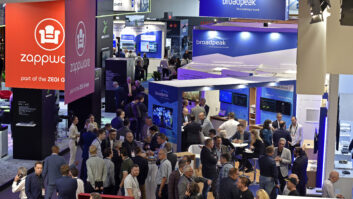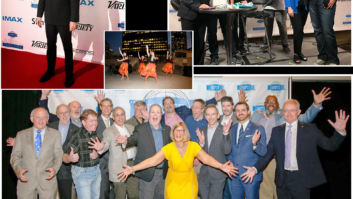Headed for Sin City? In this article, we offer a sampling of engineering sessions of interest; in the ensuing pages, we explore a few presentations in more depth and provide an exhibitor list of companies serving the radio/audio space.
WEEKEND

Sam Matheny“Tutorial: Router Configuration” — On Saturday morning of the NAB Show, Wayne Pecena, director of engineering for Texas A&M University/KAMU, will talk about routers, the heart of IP networks.
Pecena is the most recent recipient of Radio World’s Excellence in Engineering Award. Find out why by listening to this three-hour session, the first element in an all-day SBE Ennes Workshop exploring various aspects of the all-IP facility.
Broadcast Engineering Keynote — Sam Matheny will lay it on the line for engineers on Sunday morning. He’s executive vice president and chief technology officer of the NAB.
This will be his first keynote to a spring show since he succeeded Kevin Gage. Matheny is former VP of policy and innovation at Capitol Broadcasting Co. and was a principal in several of its media ventures including general manager at News Over Wireless; manager of Digital Cinema at Microspace Communications; and VP/GM at DTV Plus. To read Radio World’s interview with him last fall, see www.radioworld.com/matheny.
“The Curious Behavior of Consumer FM Receivers During Hyper-modulation” — Also on Sunday, Jeff Keith of Wheatstone explores the question of how much modulation headroom today’s radio receivers actually have. He promises to give test findings on more than 30 radio receivers; he finds that today’s radio receiver has very little headroom in the IF and stereo demodulator chip for additional modulation. To read a recent interview about this, see www.radioworld.com/keith.
“NAB Labs All-Digital AM Field Test Project” — David Layer of NAB will update attendees about the testing process on Sunday.
“Field Trial Results of AM Transmitter Carrier Synchronization” — Steve Smith and Tom King of Kintronic Labs say that such synchronization using GPS timing reference hardware “has the potential to markedly increase the effective coverage of co-channel AM stations with overlapping contours by eliminating beat frequencies and the associated noise artifacts that serve to make the reception in the fringe areas unlistenable.” They also will speak a bit later Sunday about “smart AM receivers.”
BEC Reception — Sunday afternoon at 5:30.

Behind the scenes at the Broadcast Engineering Conference last year are John Marino, David Layer, Janet Elliott and Rich Johnson.
Credit:
Photo by Mary Ellen DawleyMONDAY
“AM Radio Boot Camp” — A Who’s Who of AM radio technical experts will explore fundamentals and issues surrounding the senior band. Topics include leasing revenue, all-digital operation, MoM and safety.
“UAVs in Broadcast” — This is a batch of presentations, and much of the talk will focus on how TV stations use drones; but it’s a question that affects other broadcasters too. And — let’s face it — drones are cool. (There will also be an aerial robotics and drone pavilion in the South Upper Hall of the LVCC.)
“Emergency Alert Text Messages via Radio” — Steve Johnston gives a Monday afternoon talk about sending such text messages and how Wisconsin Public Radio did it.
“Preliminary Findings From Preparations for The IPAWS National Test” — Al Kenyon, IPAWS engineer with FEMA, gives a talk about the next national test. “Local test exercises added new insight into how the EAS pathway actually works in the real world when alerts are originated through IPAWS OPEN,” according to a summary. “Presentation will include audio/video capture file playback.” Monday afternoon.
“IEEE BTS Tutorial: RF Radiation Exposure Safety Standards, Practices and Regulations” — This late afternoon group of sessions is led by Eric Wandel of Wavepoint Research. Experts talk about FCC policies, exposure problems and other, excuse the phrase, hot topics.

Stephen Lockwood, Dan Ryson, Jeff Littlejohn and Martin Stabbert compare notes on the floor. Note that on the first day of the show, the exhibits will open an hour later this year.
Credit:
Photo by Jim PeckTUESDAY
“Personal Broadcast Platforms, Loudness and Hearing Loss” — Tuesday morning, Thomas Lund of TC Electronic will talk about early hearing loss caused by personal media players, and how “loudness wars” can play into this topic. Lund convened a work group that looked at improved measurement of SPL in such players. “The paper is facts-based without reference to any commercially available equipment,” according to a summary.
“Foolproof Aiming of Large Parabolic Dishes” — Randy Woods is director of engineering for Z88.3 Radio, WPOZ(FM) in Orlando, Fla. “The typical method of sweeping the X and Y axis for max level is a good way to get a sub-optimal link,” according to his summary. He describes a two-hour process that can address this problem; it applies to radio STL (950 MHz) scenarios as well as more modern, 6 GHz or higher, IP-based data links. His presentation is Tuesday morning.
“Network Security for Broadcast Media Streaming” — Keyur and Junius Kim of GatesAir have a Tuesday morning session. They talk denial-of-service attacks, compromise of the management plane, eavesdropping and hijacking of media streams, and describe counter measures.
“Using Real-Time Web Audio to Replace Telephone Call-ins On Air” — Tom Hartnett of Comrex discusses WebRTC, which is built into modern browsers; he says it offers stations a way to make any computer sound like a studio microphone. “We will also explore free apps that are available to turn the mobile phone into a high-quality broadcast platform.” Tuesday afternoon.
“The Audio Cloud: Decreasing Cost and Improving Reliability of Audio Links for Broadcast” — Kevin Campbell of WorldCast Systems describes a kind of audio “cloud” suitable for various audio transport applications. Topics include redundant streaming, packet forwarding, distributed intelligence and relocating the multicast or multiple unicast functionality away from the source encoder.
SBE Membership Meeting — Tuesday at 6 p.m.

Last year’s show featured a talk about RF facilities atop the Empire State Building. This year, a Saturday session highlights the new One World Trade Center.
Credit:
Photo by Jim PeckWEDNESDAY
“Digital Strategies Exchange for Radio (DSX4r)” — This is a daylong program within the Broadcast Management Conference that focuses on new technologies affecting radio broadcasting and provides recommendations for non-technical managers. Topics include sales, metrics, content, the digital dash and NextRadio.
“Hurricane Preparedness in a City Below Sea Level 10 Years After Katrina” — At an NAB Show in 2005, Joseph Pollet of Entercom Communications discussed preparedness. That was four months before Katrina. “I will recap my original 2005 presentation and further elaborate on what worked and what did not work during the storm, and its immediate aftermath, as well as the associated short and long term recovery efforts of New Orleans and New Orleans area broadcasters, all as observed through the eyes of a first-hand witness and lifelong resident.”
“RF Boot Camp” — Garrison Cavell, president of Cavell, Mertz & Associates, leads a daylong, comprehensive discussion about RF in the broadcast system, covering FM, AM and TV issues.
Technology Luncheon — John McAfee headlines Wednesday’s lunch, which will also feature presentation of the NAB Engineering Achievement Award to Tom King and Richard Friedel. (We’ll have more about King’s career next issue.) The Service to Broadcast Engineering Award goes to Ray Conover. NAB will also present its first Digital Leadership Award, “to an individual or group that has had a significant role in enabling a traditional broadcast business to succeed on digital platforms.”
Amateur Radio OperatorsReception — The tradition continues.
THURSDAY
NRSC Update — Leaders of the National Radio Systems Committee and its subgroups will update show attendees on the NRSC’s activities.
“Enhancing Broadcast with TagStation: Delivering Content to NextRadio, HD Radio and Connected Car Receivers” — This talk is by Mike Englebrecht, director of network operations for TagStation and NextRadio. “This paper will discuss the key elements broadcasters need to know about integrating metadata services into radio play-out systems and will demonstrate best practices in managing and presenting metadata in advanced receivers using TagStation, a commercially available metadata service.”
The above is a sampling; for the full track of Broadcast Engineering and Broadcast Management Conferences, see www.nabshow.com.











